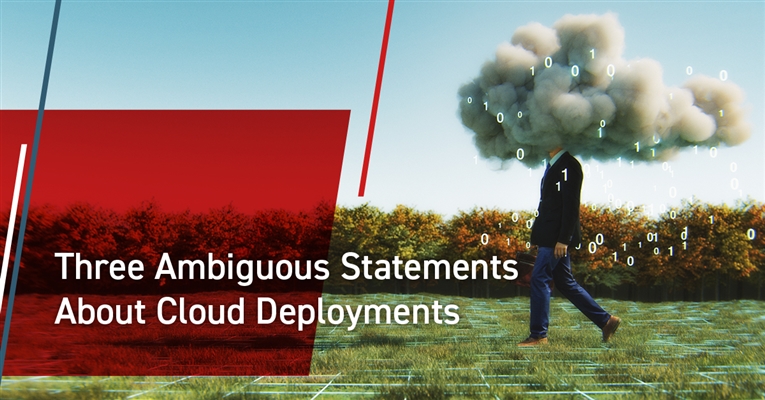Every morning I receive emails pointing me to the plethora of new technology blogs and articles published since…well, yesterday. I cannot help but notice the hundreds of new articles published every week about cloud adoption. The funny thing about the articles is that the information discussed is either at a very high level—saying the same things over and over, or at a deep, dark technical level giving way too much information for someone just starting to grasp the basics. Readers have two options—either be spoon-fed on a high-chair or drink from a fire hose. What I began to realize is the missing information residing in the in the middle is the important stuff—you know, the devil in the details. After a while, how many articles can one read on the differences between IaaS, PaaS, and SaaS, or the public cloud vs the private cloud? That part I understood (after the first thirty blogs).
Since I regularly spend considerable time weeding through way too many articles and webinars, I would like to share a few ambiguous points that might save a novice considerable time and effort.
1) “Our product is cloud ready; we have many customers on the cloud today”
This statement really confused me, especially in the PLM domain where it was very clear that cloud adoption was well behind other enterprise applications. Who were all these cloud customers the software vendors were claiming to have if no one was actually adopting?
The simple answer is, there is “being on the cloud” and then there is “really being on the cloud.” Okay, I know that did not help. To easily deploy applications on the cloud, many software vendors utilize the cloud as infrastructure (IaaS) on the virtual machine or VM level. Using this approach, an application will technically be on the cloud, but the benefits are limited because this does not fully leverage managed cloud services. To fully leverage the flexibility and efficiency of a cloud deployment, platforms must be designed to utilize managed cloud services like cloud-based orchestration, storage, and databases to ensure that their cloud strategy attains the benefits of the cloud. In the case of most legacy software products, existing software must be re-architected to support managed cloud services—a costly process. So, while vendors are claiming they have many customers on the cloud, are they really on the cloud?
2) Managed Cloud Services (Managed Cloud-Based Services) vs Managed Services (sometimes called Managed Cloud Services)
Seriously?
I know it is hard to see but these are two completely different things, well, kind of.
In the last section I mentioned managed cloud services. The context of that phrase is that there are many products on the cloud designed to optimize the cloud environment. The cloud gives great managed services to support code orchestration and execution, data storage, and network management. These products are key for driving the value out of a cloud deployment and, without them, the value and flexibility of a cloud deployment could be limited. Companies need to understand if their software can leverage managed cloud services before moving forward.
The second “managed services” refers to a service offering to manage a company’s cloud environment, offloading the day-to-day activities of their data center to an outside vendor. Typical activities delivered by a managed service provider may include a combination of hardware and software management, security and risk management, storage management, performance monitoring, help desk technical support, and many other tasks.
3) If SaaS is a great option what I am giving up?
This is not really an ambiguous question, but it is a great question. The list of cloud benefits goes on and on, but nothing is free. What’s the catch?
In a word, control. This happens in several ways, but for the purposes of this blog, I am going to focus on application software. The basic business model for SaaS providers is to manage as many customers as possible in the same environment and on the same exact software version at the same time. While this drives a huge benefit of scale for the provider, it also forces customers to accept solutions and processes the way their vendors design them.
For some companies, especially smaller ones, this may not be so bad. It forces businesses to adapt to standard business process and eliminates (or at least significantly limits) the amount of investment they make in customizing their applications. Without customizations, their upgrade processes run smoother with vendors implementing their latest changes on a regular schedule.
Unfortunately, for large, complex companies this is rarely acceptable—especially in the PLM domain. Large companies have unique business processes and requirements that drive their competitive edge in their industries. Very few, if any, large companies have ever used a PLM system out of the box, so it seems unrealistic to expect them to adapt to an out of the box, restrictive SaaS offering. Once customized, upgrading the system creates risks unless properly tested, planned, and scheduled. When working in a SaaS environment, large companies lose control of making these decisions and need to align to the vendor’s schedule.
Only Aras Cloud
Cloud deployments and SaaS offerings are quickly becoming the first choice for system deployments. The benefits can be gamechangers for companies, but as I mentioned before, the devil is in the details.
Aras Enterprise SaaS offers customers the only PLM platform where subscribers can fully customize their platform and build unique solutions in a cloud native environment with no limits to complexity, no limits to size. Oh yes…and upgrades are delivered on the customer’s schedule. Read more about Aras’ cloud strategy in CIMdata’s Interview with Mark Reisig, Aras' VP of Product Marketing.

